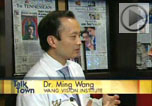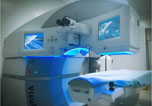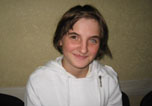- Over 55,000 LASIK and cataract procedures (including on over 4,000 doctors)
- The FIRST center in TN to offer Laser Cataract Surgery
- Introduced bladeless all-laser LASIK to the state
- Implanted the state's first FOREVER YOUNG™ Lens
- The first surgeons in the US to perform a new Intacs surgery to treat keratoconus
- Helped patients from 40 states and 55 countries
- International referral center for cataract surgery and LASIK complications
- Read Dr. Wang's book: LASIK Vision Correction
Why did you decide to have LASIK? Why did you choose Dr. Wang? How has your life changed since your LASIK procedure?
What is your advice for people considering LASIK?
Click to read more
Phaco-free all-laser cataract surgery
Ming Wang, MD, PhD, Wang Vision 3D Cataract and LASIK Center, Nashville, Tennessee
Phaco-free all-laser cataract surgery
Ming Wang, MD, PhD
The advent of the femtosecond laser for cataract surgery in recent years1, 2 has ushered in unprecedented possibilities for the development of new surgical techniques. Last year we acquired a LenSx laser (Alcon, Fort Worth, TX) and have performed a large number of procedures. We have also used it to devise a new surgical technique, a phaco-free all-laser procedure, by taking advantage of the unique intrinsic capability of the laser itself, i.e. its ability to pre-chop the lens in a closed chamber in vivo.
Thirty years ago Charles Kelman developed phacoemulsification3. However, despite the significant technological improvement in the past three decades, phaco itself still remains the key culprit for major complications in cataract surgery such as posterior capsular break and corneal edema. To reduce these complications, ideally one would want to completely eliminate the use of phaco altogether. The phaco-free technique described here accomplishes that.
The phaco-free all-laser technique:
- Femtosecond laser capsulorhexis and lens fragmentation
Using the LenSx laser, we perform a capsulotomy, a cylindrical lens cut and a cross-hair cut.
- Hydrodissection and floating of the lens into the Anterior Chamber (AC)
Enveloped by epinucleus, the laser pre-chopped lens is spun and floated into the AC as one piece (Photo 1).
- Cracking of laser pre-chopped lens into small fragments
Under Viscoat (Alcon, Fort Worth, TX) and with 180-degree opposing action, the lens is cracked into small fragments by a spatula and a second instrument (Photo 2).
- Lens fragment aspiration
Using a large-pore phaco tip (1.1 mm in diameter), lens fragments are aspirated (with no phaco energy) assisted by a second instrument.
Discussion
Prior to the advent of the femtosecond laser, which has a unique intrinsic capability of being able to prechop the lens in a closed chamber in vivo, it was difficult to crack the lens into fragments small enough to be aspirated directly without the use of phaco. Due to its mechanism of tissue cutting (via plasma wave generation and the formation of cavitation bubbles which push adjacent tissue apart), we found that the femtosecond laser not only cuts the lens, but also appears to soften the adjacent lens tissues along the cut plane as well, greatly facilitating subsequent mechanical cracking. At deeper tissue levels the laser is less focused, resulting in larger cavitation bubbles. While this is undesirable for the cornea in LASIK (e.g., a 200-um flap interface is much more coarse than that of 100-um flap), it is actually a desirable feature of the laser for lens surgery, since larger cavitation bubbles result in a larger area of laser-tissue interaction, and therefore possibly a greater degree of adjacent tissue softening, which is critically important if this phaco-free technique is to work.
With regard to the pattern of laser fragmentation, we experimented with various designs and found that while a lesser amount of laser fragmentation hinders subsequent mechanical cracking, excessive amounts of laser fragmentation are also problematic because too many lens tissue planes are created, which stir up cortex material and reduce the visibility of the capsulotomy edge. Below are our optimized laser parameters for use in the phaco-free all-laser method:
- Capsulotomy: 5.25 mm diameter.
- Cylindrical lens cut: 3.0 mm diameter.
- Cross-hair lens cut: 5.0 mm diameter.
Additional pearls for the phaco-free technique:
- Large phaco-tip pore size: In order for this phaco-free technique to work, the phaco tip’s pore size needs to be as large as possible. The most commonly used size is 0.9 mm in diameter. We use the largest commercially available size (1.1 mm).
- 180-degree cracking in AC: Traditional phaco-chop techniques have two cracking instruments coming from the same side of the lens and are thus less mechanically efficient. The 180-degree opposing cracking action used in this technique is much more efficient.
- High vacuum for aspiration: We use a vacuum level of 650 mm Hg with no phaco.
In summary, the recent availability of the femtosecond laser for cataract surgery has made possible the development of new surgical techniques such as the phaco-free method described here. It completely eliminates the use of phaco, the key culprit that leads to complications in cataract surgery today. Using this phaco-free technique, we have now seen a reduction of surgical complications (less posterior capsular breaks) and an improvement in the postoperative vision (clearer corneas). We believe that further refinement of this phaco-free all-laser technique could represent a significant innovation in cataract surgery. So, thirty years after the invention of phacoemulsification, it may now be the time to make it obsolete.
Dr. Ming Wang is a Clinical Associate Professor of Ophthalmology at the University of Tennessee, Director of Wang Vision 3D Cataract & LASIK Center. Dr. Wang has no financial interest in any of the products discussed. He can be reached at drwang@wangvisioninstitute.com. He wishes to thank Dr. Michael George for assistance in the preparation of this manuscript.
Captions:
Photo 1: The laser pre-chopped lens is spun and floated into the AC in one piece.
Photo 2: The laser pre-chopped lens is mechanically cracked into small fragments for aspiration.
References:
- He L, Sheehy K, Culbertson W. Femtosecond laser-assisted cataract surgery. Curr Opin Ophthalmol. 2011 Jan;22(1):43-52. Review.
- Nagy Z, Takacs A, Filkorn T, Sarayba M. Initial clinical evaluation of an intraocular femtosecond laser in cataract surgery. J Refract Surg. 2009 Dec;25(12):1053-60.
- Kelman, C.D. Phacoemulsification and Aspiration. American Journal of Ophthalmology, Volume 64, No.1 July 1967.
Our new texbooks
A 501c(3) charity that has helped patients from over 40 states in the US and 55 countries, with all sight restoration surgeries performed free-of-charge.




















